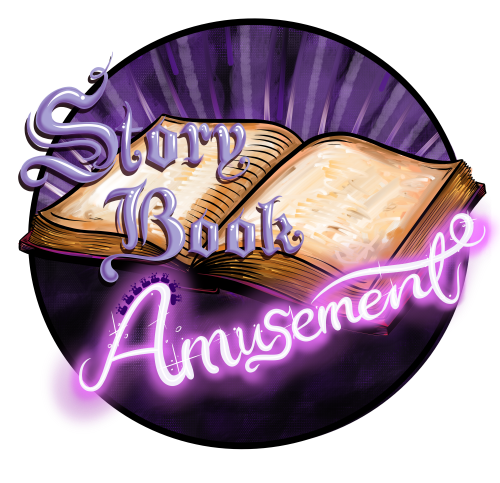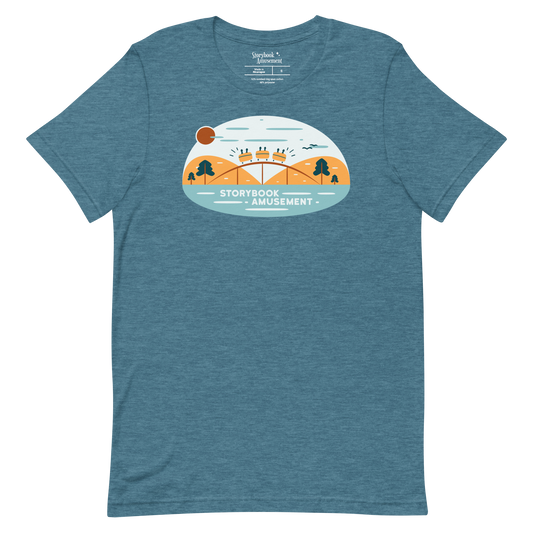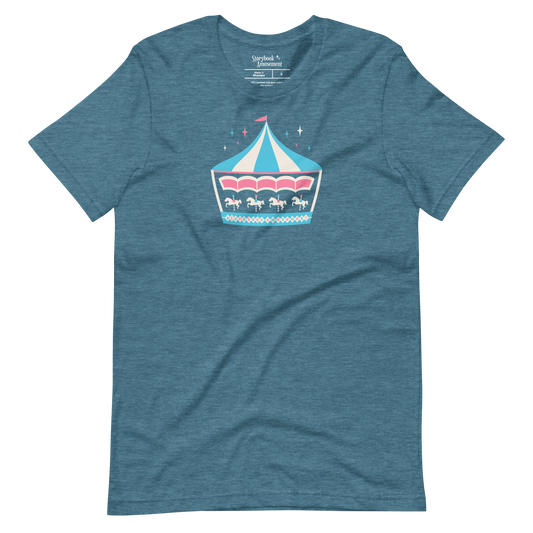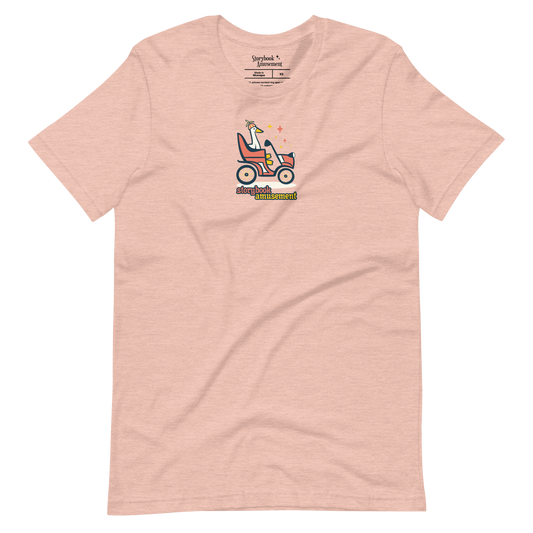An Old Tradition Begins
Kennywood in its early years was dream-like. At the turn of the 20th century, the up-and-coming Pittsburgh picnic park had a promising future. With new trolleys and a 12,000-square-foot dance hall, the park continued to invest in new attractions to draw in crowds.
In the 1901 season, Kennywood introduced one of the world’s earliest boat dark rides: The Old Mill. Powered by a waterwheel, The Old Mill took riders through dark, narrow canals and themed sets.
In the ride’s earliest years, park management changed the theme of The Old Mill every few seasons to attract customers year after year. Even though the ride track stayed the same, the attraction itself was outfitted differently to keep it fresh.
Not much is known about the first iteration, but it is assumed to have been a spooky theme. Soon after, the ride took on a Fairyland Floats theme, then The Panama Canal for three years during the construction of the actual Panama Canal, and then Rapid Gorge, with earlier themes returning for a few seasons.
In the mid-1920s, only two decades after opening, The Old Mill ride burned to the ground. But, the park saw so much value in the attraction that they weren’t ready to move on despite the major loss. Park management decided to completely reconstruct The Old Mill, reopening it in 1926.
Kennywood maintained a steady business plan during the Great Depression of the 1930s. Kennywood, like many businesses, struggled through these difficult years, but the park survived thanks to the stability and success of its popular dance hall and beloved existing attractions. The rebuilt ride was a staple in the park’s lineup.
Watch on YouTube
This article is available in video form with accompanying visuals. Click HERE to watch it.
A Hardheaded Era
Decades passed, and by 1974, park management decided The Old Mill could use another overhaul, now being remodeled to an old west design. With an updated theme, the ride operated under the super easy-to-remember, simple-to-say name Hardheaded Harold’s Horrendously Humorous Haunted Hideaway.
Like versions of the ride before, the attraction had guests board small boats seating two riders per row. They floated through dimly lit passageways, taking guests through indoor and semi-outdoor scenes of the old west, including a saloon, a graveyard, a blacksmith’s forgery, a jail, and more. With skeletons and old-timey characters throughout, the ride had an ambiance and feeling about it.
Hardheaded Harold’s Horrendously Humorous Haunted Hideaway didn’t necessarily have a great story, but the setting and sequences added up to something memorable—an attraction that was important to the park’s history and those who visited. Even though the attraction had a track record early on of being redecorated quite often to attract crowds, this version of the ride stayed for decades.
Harold’s Horrendously Humorous Haunted Hideaway left an impression on anyone who grew up in the area through the ‘70s, ‘80s, and ‘90s. For some, it was even a right of passage. The ride was Kennywood’s very own tunnel of love, though, that was never the ride’s official name.
Speaking of its name, in 1992, Kennywood recognized how impactful the ride was to the park’s tradition as they retired the Hardheaded Harold name and revived the classic Old Mill name. The ride would operate for many more years, becoming a classic in the theme park world.
Finding a Replacement
As the 20th century came to a close, theme parks across the country were using mascots in their marketing efforts. Disney parks of course had Mickey Mouse. Universal parks put Woody Woodpecker on much of their promotional materials. The Six Flags chain relied on the Looney Tunes characters, mainly Bugs Bunny. And Cedar Fair parks, such as Knott’s Berry Farm and Cedar Point, were represented by Snoopy and the Peanuts.
Kennywood since the 1970s has had its own original character: Kenny the Kangaroo. But, given the trends in the industry, the small theme park wanted a more recognizable figure in order to stand out. In the early 2000s, Kennywood partnered with cartoonist Jim Davis to bring Garfield into the park. The same apathetic, Monday-loathing cat from the Sunday funnies was suddenly the snide face of the park.
From being featured on the park’s maps to having walkaround characters, Garfield had a prominent presence in the park. Kennywood’s Kiddieland area got a new Garfield attraction along with some decorations. Garfield would soon make a bigger impact in the park beyond Kiddieland.
Kennywood Looks for Change
At this time, park management recognized the 100-year-old Old Mill attraction was becoming difficult to maintain and didn’t justify its large footprint.
The decision was made to close The Old Mill after a century of operation.
The ride was a Kennywood tradition, but regardless, it would serve its final season of operation in 2003. Kennywood opted not to tear down the ride building as the park has a rich past and prides itself in preserving that history, despite preparing to overhaul the attraction.
The existing infrastructure and ride system were in the park’s plans for a new experience—a ride that would appeal to visitors and would potentially sell more merchandise. Kennywood put together a small budget to transform the attraction.
The park made improvements to the attraction’s ride system, but the major changes would be in its theme. The historic Old Mill ride, as Kennywood settled on, would soon be the first major attraction for the park’s recently acquired character: Garfield.
Given the magnitude of Garfield—holding the world record for being the most widely syndicated comic strip—it would be easy to assume the lovable, sarcastic cat was deserving of one of the best rides Kennywood has ever built. After all, Kennywood changed the theme of the former Old Mill year after year early on to draw crowds. Wouldn’t a well-done Garfield attraction accomplish that same goal?
Well, the project had many limitations. The two main drawbacks of the ride’s development were its tight budget and the antique ride system. Since the upcoming Garfield attraction would use the same ride system as the defunct Old Mill, it would be restricted to an incredibly low-capacity. Essentially, the boat ride could accommodate about as many riders per day as a high-capacity ride could accommodate in a few hours.
With that in mind, Kennywood didn’t want the ride to have a high demand that would cause long waits and lines that would extend beyond the queue space. The park’s solution was to cut corners and make it a less appealing ride than they were capable of. In an incredibly in-depth article about the attraction’s development written by Boaz Frankel of Very Local, the attraction’s creator, Larry Kirchner, was told, “We can’t make it too great because too many people would want to ride it.”
Dreaming Up Kennywood's Next Dark Ride
With their standards set, Kennywood collaborated with Jim Davis and Halloween Productions, owned by Larry Kirchner. Originally, Kirchner had plans to incorporate elaborate CGI and animatronics, but due to the limitations in the budget, ride system, and—well—expectations for the attraction, he went in a simpler direction.
The ride’s creators took a more fundamental approach, choosing to format the ride in a way that Garfield was most famous for: comic strips. They would create panels and captions for riders to float by in addition to show scenes.
As for the story they would tell, Kirchner and his company, Halloween Productions, specialized in haunted attractions, so it was fitting for them to come up with a darker setting.
They settled on a nightmarish concept that would take riders through Garfield’s darkest dreams. And so, the attraction earned its new name: Garfield’s Nightmare. While Halloween Productions had many restrictions, even being told the ride couldn’t be too good, the team put their best effort forward given the circumstances.
They crafted character cutouts and set pieces, giving the ride a classic haunted house feel. Once the set pieces were installed and the ride got its new overlay, Garfield’s Nightmare was soon to become everyone’s nightmare.
The Nightmare Begins
After a quick retheme and four-month turnaround, Garfield’s Nightmare opened May 1, 2004. The bulky Garfield and Odie costumed characters got into one of the ride’s small boats and were dispatched for the attraction’s inaugural voyage.
At the time, the attraction was something new, something fresh; there was an excitement about it that would soon turn to disappointment. It was a slow-paced ride that, by design, was suitable for kids; but by execution, it was a bit intense.
The Ride Experience
Just inside the ride, guests were immediately met with blatant, unashamed product placement, introducing riders to the attraction’s signature, stark blacklight style.
Garfield’s Nightmare had a story of Garfield taking a satisfying nap after a gluttonous episode. Once asleep, he would be devoured by his most dreadful dreams. Riders wore 3D glasses and experienced this string of nightmares one by one.
No two scenes really had anything to do with each other outside of the loose setup of Garfield falling asleep. Each scene was introduced with a static comic strip that roughly related to what riders were about to witness.
The scenes were all cartoonish nightmares you would expect from a cat—scenes of Garfield’s world turned vile. The nightmare started with a cut-throat ice cream truck sneering at Garfield. Next was a menacing mail-carrier and a devilish dog with razor-sharp teeth.
The nightmare then showed riders a sinister spider, a gruesome goldfish, and a vicious visit to the vet. The ride continued with the chubby cat’s worst nightmare: food that was trying to eat him for once, including a Frankenweenie and a pizza with pointed teeth.
In the ride’s final major scene, murderous mice were cooking a cat stew, preparing their main ingredient: Garfield. The boats passed through a passage recapping the nightmares, then a series of alarm clocks to wake up Garfield, and ending with a photo op before arriving at the unload station.
Reception
Garfield may have woken up from his nightmare at the end of the ride, but it was just beginning for Kennywood. This wasn’t a seasonal overlay; it was a permanent installation that would haunt the park and its guests for years to come.
While the attraction had expressive sets, the ride overall was not particularly engaging. Its tight corridors, unsettling aesthetic, and uncomfortable yet ineffective soundtrack combined for an unnerving atmosphere that didn’t generally resonate with riders. Not to mention, Garfield’s Nightmare took over a memorable and historic dark ride that countless visitors had an emotional connection to.
The exterior and queue of Garfield’s Nightmare still held The Old Mill’s aesthetic. But the interior was completely transformed, even enclosing the building’s semi-outdoor sections that gave the previous ride its charm.
It quickly became one of the most controversial rides in the park’s history. Many riders would toss their 3D glasses onto the various sets, showing their distaste and disinterest in what the ride had become. Despite the screams, Kennywood took years to end the nightmare.
The End of a Nightmare
Kennywood, being among the oldest theme parks in the country, is persistent about embracing its history, honoring the past, and improving the guest experience by doing so when possible.
After all, this is the same park that heavily modified its Steel Phantom coaster after criticism of an unbearable ride experience, converting it into the much more enjoyable Phantom’s Revenge in 2001. Kennywood did what they could to preserve enough of the ride’s history while reconfiguring and improving the track for better guest satisfaction. This is just one of many examples, as Kennywood has restored Noah’s Ark and other attractions too.
Meanwhile, after nearly two decades of underwhelming operation for Garfield’s Nightmare, there was an outcry among fans for The Old Mill to return. The ride was popular in the hearts of so many with a connection to the park.
“It’s always hard to compete with people’s memories. That’s always a big challenge here at Kennywood. We try to walk a fine line between staying on the cutting edge and staying modern while also honoring the past and people’s memories.” — Nick Paradise, Kennywood’s director of public relations
Garfield’s Nightmare had been wearing down over the years. It seemed to be the park’s most disliked ride. By the 2020s, the park was facing higher licensing fees for the rights to Garfield, and Kennywood didn’t see the value in keeping him around. Many theme parks may have taken this type of opportunity to repurpose the ride’s large plot of land for a state-of-the-art thrill ride. Kennywood, committed to its legacy, took that chance to revive the oldest operating boat ride in the country. In 2020, 16 years after Garfield’s Nightmare opened, Kennywood announced the nightmare was over. The Old Mill would return to the venue it occupied for a century. Kennywood partnered with ScareHouse and quickly rethemed the attraction to its former old west setting. Kennywood’s new Old Mill opened to guests in summer 2020. Using the same century-old ride system and technology, the updated Old Mill has similar blacklight effects that Garfield’s Nightmare was notorious for, but now in a much more charming setting. Ideas from the original ride were brought back, such as the skeletons, blacksmith, graveyard, and saloon.





